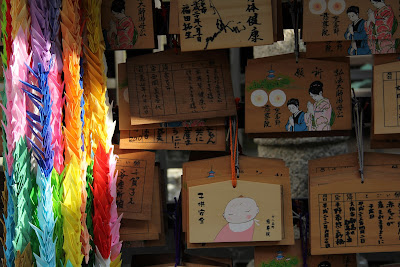Yesterday I had one of my most interesting experiences while in Japan. I went to see sumo morning practice "asa geiko". Since Natalie is visiting Japan in February there are no sumo tournaments going on right now. I still wanted her to experience this aspect of japan, so the solution was to go straight to the source and see sumo morning practice at a sumo stable.
Yes, that is right, the building where a group of sumo wrestlers live and train is called a "stable". We called Fujishima-beya, a stable here in Tokyo and they welcomed us to visit them during morning practice from 6 to 9 AM.
 |
| The main entrance to Fujishima-beya |
It was bright and early when we reached our destination in Uguisudani station and we knew we had reached the beya when we heard the rikishi grunting from the street adjacent to the beya. We were really nervous when we rang the door to the beya. When one of the rikishi opened the door we totally froze but he was nice and let us in.
We got invited in and sat on the tatami mat to watch the practice. Unlike sumo matches at the stadium, where fights last less than 30 seconds and are followed by long periods of religious rituals, the practice was intense, with matches happening quickly and successively.
The practice hall is a long room with a raised tatami floor were the beya owner and the coach sit. And the clay pit with the rope delineating the sumo ring "dohyo".
The first thing we saw were rikishi charging and resisting. One rikishi charges from outside the ring, while another rikishi tries to hold ground and act as resistance as he gets pushed across the circle. They would then switch roles and repeat. They would then practice falling by doing shoulder rolls.
Then, two rikishi that appeared senior started practicing. They would fight over and over with almost no breaks in between. I had never seen rikishi up close like this or fight continuously before, and I was amazed at the physical exertion of the practice and the athletic ability of the rikishi.
I had already concluded on previous sumo watching that rikishi have an incredible amount of muscle underneath their fat. Being so close to the rikishi made me realize this again in a whole other level. Their leg muscles looked like tree trunks, it was incredible.
So what do the other rikishi do when there are two rikishi practicing in the ring? They are all practicing really really hard outside of the ring. This rikishi is holding a marble/stone ball and then he would proceed to do sqwats with it. It was incredible, it made my four-day-a-week gym routine look like baby's work.
 |
| Rikishi training on the side | | | |
|
Here I will add my girly comment of the day. You would think that a practice room that includes 20 guys sweating like machines would be the stinkiest place on earth. I was very surprised but the room had a very pleasant and earthy smell. It smelled like clay and tea seed oil, which the rickishi use on their hair.
Lastly, at the end of the practice the coach went into the pit and the rikishi started practicing "dohyo-iri", which involved raising their legs high and then stomping on the ground to drive evil out of the dohyro. They would do sets of ten, over and over and over again. I was surprised that they where able to do that after all the other practice that had taken place earlier.
 |
| Dohyo-iri |
After the morning practice was over, the rikishi gathered in a circle, recited things in Japanese that I unfortunately could not understand. Then they bowed at the shrine in the practice room and left.
Natalie and I thanked the coach and owner and stepped outside into the crisp cold and bright day feeling like we had stepped out of a dream. It was very clear that we did not belong there (two non-japanese girls in a heya with 15 rikishi, you bet that we do not belong there) and we had the feeling that this was an authentic experience of their every-day lives, not a show for tourists.We felt like we witnesses something that few people (let alone Westeners) are able to see. It was very special.

































































